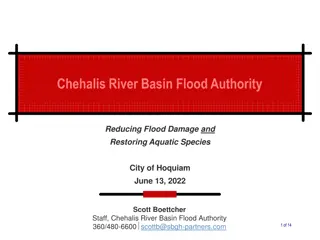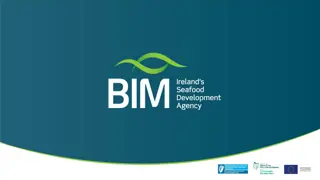Developments in Establishing Quantitative Objectives for Salmon and Steelhead in the Columbia Basin
The Columbia Basin Partnership Task Force, led by NOAA, has been working on setting shared, quantitative objectives for salmon and steelhead in the Columbia Basin. The process involves creating prototype work teams to test and develop these objectives, with a focus on areas like the Snake River Basin. Idaho has taken a lead role in objective development for the Snake River Sp/Su Chinook Prototype Team. The involvement of various stakeholders from government offices, conservation groups, and tribal entities underscores the collaborative effort towards sustainable salmon and steelhead populations in the region.
Download Presentation

Please find below an Image/Link to download the presentation.
The content on the website is provided AS IS for your information and personal use only. It may not be sold, licensed, or shared on other websites without obtaining consent from the author. Download presentation by click this link. If you encounter any issues during the download, it is possible that the publisher has removed the file from their server.
E N D
Presentation Transcript
The Columbia Basin Partnership Task Force A NOAA-led effort to establish shared, quantitative objectives for salmon and steelhead in the Columbia Basin Governor s Salmon Workgroup Meeting October 29-30, 2019 Twin Falls, Idaho 1
Outline Build on Katherine s presentation focus on how quantitative objectives for salmon and steelhead were developed for Snake River Basin. 2
Quantitative Objectives Work Teams Five Prototype areas (and work teams) were created to test drive the process of setting quantitative objectives for salmon and steelhead. Upper Columbia Su. Chinook C.R. Coho C.R. Chum Mid C.R. Steelhead S.R. Sp/Su Chinook Other stocks came later 3
Quantitative Objectives Work Teams Idaho identified its interest in leading objective development for the Snake River Sp/Su Chinook Prototype Team. 4
Snake River Work Team Participation Mike Edmondson, Jim Yost Idaho Governor s Office Paul Kline Idaho Department of Fish and Game Dan Rawding Washington Department of Fish and Wildlife Tucker Jones Oregon Department of Fish and Wildlife Rob Masonis Trout Unlimited Kurt Fesenmyer Trout Unlimited John McMillan Trout Unlimited Burt Bowler Idaho Salmon Group Bob Lessard Columbia River Inter-tribal Fish Commission Zach Penney Columbia River Inter-tribal Fish Commission Bob Austin Upper Snake River Tribes Foundation Scott Hauser Upper Snake River Tribes Foundation John Foltz Snake River Salmon Recovery Board Steve Martin Washington Governor s Salmon Recovery Office Paul Arrington Idaho Water Users Association Jay Hesse - Nez Perce Tribe Dave Johnson Nez Perce Tribe Bill Bradbury Oregon Governor s Office John Simpson Barker Rosholt & Simpson LLP Liz Hamilton Northwest Sportfishing Industry Association Rod Sando Northwest Sportfishing Industry Association Russ Thurow USFS, Rocky Mountain Research Station NOAA Fisheries Snake River Working Group 5
Quantitative Objectives Work Teams Quantitative Objectives Framework Sustainability (conservation) How many natural-origin fish do we want spawning in the habitat? Fishery (harvest) How many natural- and hatchery origin fish do we want to harvest? Mitigation Are hatchery mitigation goals being met? 6
Quantitative Objectives Work Teams Guidance provided by NOAA - Objective, defendable and time bound. Don t need to answer how do we get there. 7
Quantitative Objectives Work Teams Healthy and Harvestable Now Delist (MAT) Historical 2017 25yrs? 50+yrs? > 100 yrs First priority Assignment objective defendable Avoid 8
Snake River Work Team The Work Team focused first on Spring/Summer Chinook Salmon 9
Snake River Work Team Did any objectives or goals already exist? NOAA delisting goals for natural-origin fish Snake River Sp/Su Chinook (ESU) Includes 5 major population groups (MPG) 32 populations Minimum Abundance Threshold (MAT) = 31,750 What is healthy and harvestable goal = ??? Hatchery mitigation goals for Sp/Su Chinook LSRCP = 58,700 IPC ~ 31,000 Is hatchery goal being met??, Is it adequate ?? ~ 90,000 10
References Used Natural-origin fish Idaho toolbox Historical accounts of abundance Pre-western development, 1950 s on Long time-series of spawner info (redd counts) from 1957 forward Snake River dam counts (1962 forward) Planning assumptions for LSRCP hatchery mitigation program 11
References Used Natural-origin fish Historical accounts (spring Chinook): 1890 1895 ~ 600,000 returns to the Snake Late 1950s to early 1960s 120,000+ wild fish to the Snake Recent Lower Granite Dam counts: ~25,000 wild fish (10 yr avg) 45,381 wild fish in 2001 12
References Used Natural-origin fish Regional planning goals: NPCC document ~80,000 natural-origin fish (CLW + SAL) LSRCP hatchery mitigation planning Used 122,000 as the starting number 13
References Used 1950 s Pre-Snake Dams Fall Chinook = 32,700 Sp/Su Chinook = 122,200 Steelhead = 114,800 Hatchery Mitigation Fall Chinook = 18,300 Sp/Su Chinook = 58,700 Steelhead = 55,100 15
References Used 103,000 sp/su CH 143,000 Sthd Wild/Natural 16
References Used Proposed Escapement Goals (Wild/Natural) Sp/Su Chinook = 134,000 Steelhead = 92,000 Sockeye = 6,000 17
References Used 77,300 sp/su CH 66,000 Sthd Wild/Natural 18
References Used Wild/Natural Sp/Su Chinook Salmon, Clearwater, Snake 54,048 at Lower Granite /.70 = 77,225 20
References Used Wild/Natural Steelhead Salmon, Clearwater, Snake 54,846 at Lower Granite /.70 = 78,351 21
References Used Wild/Natural Sockeye Snake Basin Lakes 10,432 at Lower Granite /.70 = 14,902 22
References Used 93,500 sp/su CH 140,000 Sthd Wild/Natural 210,200 sp/su CH 314,200 Sthd Wild/Natural + Hatchery Asotin, Grand Ronde, Imnaha, Lower Snake Mainstem, Tucannon, Snake Hells Canyon 25
References Used IDFG Redd Count Database MAT = 1,000 26
References Used Snake River Dam Counts 27
Proposed Snake River Objectives Crosswalk with NOAA Minimum Abundance Thresholds Spring/Summer Chinook Salmon: 127,000 = 4.0 x MAT Fall Chinook Salmon: 14,360 = 3.4 x MAT Summer Steelhead: 104,500 = 5.0 x MAT Sockeye Salmon: 9,000 = 3.6 x MAT 29
Deciding on a Common Place to Count Natural-origin fish 127,000 30
Deciding on a Common Place to Count Natural-origin fish 127,000 Factor terminal number back to the mouth of the Columbia River 31 31
Deciding on a Common Place to Count Natural-origin fish 4,000 Identify terminal population goal: Identify terminal harvest rate: Identify natural loss upstream of LGR: ______ Calculate adjusted passage at LGR: ______ ______ 20% 10% 5,556 ______ Upper Salmon Population 32
Deciding on a Common Place to Count Natural-origin fish ______ 5,556 8% 5% 6,356 Identify LGR passage number: Identify MCN to LGR harvest rate: ______ Identify natural loss MCN to LGR: ______ Calculate adjusted passage at MCN: ______ Upper Salmon Population 33
Deciding on a Common Place to Count Natural-origin fish 6,356 30% 10% Identify MCN passage number: Identify BON to MCN harvest rate: Identify natural loss BON to MCN: Calculate adjusted passage at BON: ______ ______ ______ ______ 10,090 Upper Salmon Population 34
Deciding on a Common Place to Count Natural-origin fish 10,090 10% 20% Identify BON passage number: Identify CR mouth to BON harvest rate: Identify natural loss CR mouth to BON: Calculate adjusted passage at CR mouth: ______ ______ ______ ______ 14,013 Upper Salmon Population 35
Deciding on a Common Place to Count Natural-origin fish 36
Establishing Hatchery Objectives Hatchery-origin fish Why Hatcheries? Fulfill mitigation promises Treaty Tribe rights 50% 37
Establishing Hatchery Objectives Hatchery-origin fish LSRCP IPC 38
Establishing Hatchery Objectives Hatchery-origin fish LSRCP adult goals 58,700 adult fish upstream of LGR (includes broodstock need). 4:1 mitigation ratio downstream of LGR. 4 x 58,700 = 234,800. Total LSRCP mitigation = 58,700 + 234,800 = 293,500. 39
Establishing Hatchery Objectives Hatchery-origin fish IPC goals Lbs. or #s of smolts released. Converted to LSRCP equivalents = 31,300 adult fish. 4:1 mitigation downstream of LGR. 4 x 31,300 = 125,200. Total mitigation = 31,300 + 125,200 = 156,500. 40
Establishing Hatchery Objectives Hatchery-origin fish Hatchery Mitigation = 450,000 LSRCP = 58,700 IPC = 31,300 Total = 90,000 LSRCP = 234,800 IPC = 125,200 Total = 360,000 41
Establishing Hatchery Objectives Hatchery-origin fish Hatchery-origin sp/su Chinook returns to LGR Are we meeting mitigation objectives? Aggregate mitigation goal upstream of LGR (90,000) 42
Establishing Hatchery Objectives Natural- & Hatchery-origin fish Terminal goals (MAT = delisting). 31,750 natural-origin sp/su Chinook. Terminal goals (healthy and harvestable) 127,000 natural-origin sp/su Chinook. 90,000 hatchery-origin sp/su Chinook. C.R. mouth goals (healthy and harvestable). 444,925 natural-origin sp/su Chinook. 450,000 hatchery sp/su Chinook. 43
Establishing Hatchery Objectives Natural- & Hatchery-origin fish Upstream of LGR Natural = 127,000 Hatchery = 90,000 Total = 217,000 At C.R. mouth Natural = 444,925 Hatchery = 450,000 Total = 894,925 44
Marine Fisheries Federal Advisory Committee (MAFAC) Phase 1 Report accepted by Chris Oliver, Assistant Administrator for NOAA Fisheries on July 10, 2019 45
Total wild-natural escapement goal identified for Columbia River Basin salmon and steelhead = 3,580,110 46
Questions ? 47


![[✔PDF✔⚡] ✔DOWNLOAD✔ Ancestral Knowledge Of Smoking Salmon: The Ultimate Gui](/thumb/68084/pdf-download-ancestral-knowledge-of-smoking-salmon-the-ultimate-gui.jpg)




















